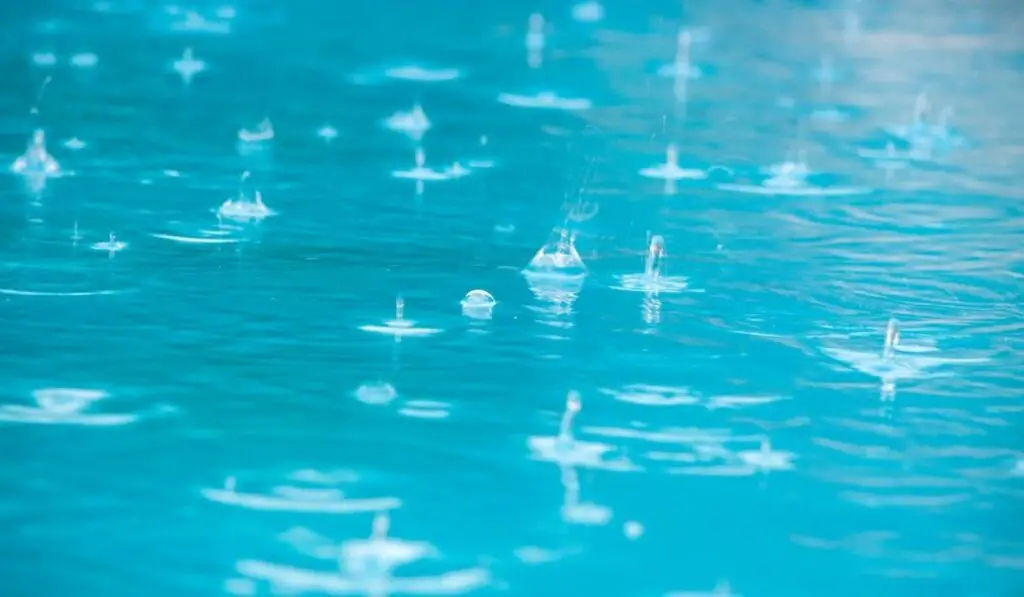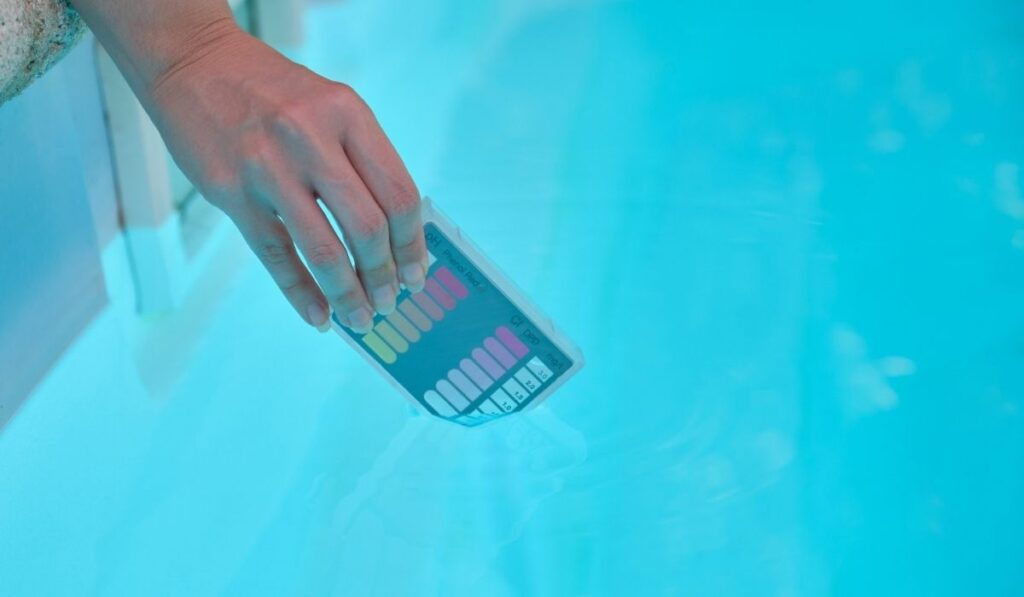Rain and heavy storms can be a real nuisance for pool owners. Such weather conditions can bring twigs, leaves, and other debris into the pool, which you’ve then got to clear out. But an even bigger risk for pools when it comes to rain and heavy storms is that they can negatively impact your pool’s chemistry.
The most important thing to do after it rains or storms is test your pool water. Rain can impact pH levels, alkalinity, calcium hardness, and chlorine. Before you test and adjust the chemicals, you can check the water levels, circulate the water, skim out any debris, and clean the interior.
Don’t panic if it just rained and you aren’t sure what to do. Fixing your pool after a heavy storm is a straightforward process and will become a part of your routine in no time. Practicing the best maintenance methods will keep your pool clean and healthy. Let’s look at what you should do to your pool after it rains.
Will Rainwater Hurt Your Pool?

Rainwater can negatively impact the chemistry of your pool water in a variety of different ways. Rain can impact the pH levels, alkalinity, calcium hardness, and chlorine — and bring other debris and bacteria into your pool’s water.
Heavy storms can also raise the water level in the pool, causing the skimmer to stop functioning. High water levels causing overflowing can dilute your pool chemistry a lot, and right at the same time that the rain and wind are dragging dust and debris in. Let’s look closer at the effects of a storm on your chemistry levels, and then we’ll turn our attention to what to specifically do after a storm.
pH Levels
Rain absorbs low pH contaminants as it falls to earth. Still, low pH rain might not affect your pool too much unless it’s from heavy storms over a few days.
Rain can also become acidic if it absorbs carbonic acid or sulfuric acid as it falls from the sky. Either way, you’ll need to check your pool’s pH levels after it rains and potentially increase them.
Alkaline Levels
Rain can decrease the total alkalinity levels in the pool over time, requiring you to increase the alkaline levels. Rainwater has near-zero alkalinity, which means it can dilute the pool water, causing the levels to drop by 5-10 ppm a day.
Low alkalinity and low pH levels in swimming pools can create corrosive water conditions. Corrosive water can damage the metal surfaces, pumps, filters, and even the masonry or vinyl liners.
Calcium Readings
Rainwater is soft water, meaning it has near-zero hardness. If you have a soft water pool, rainwater can decrease the pool’s calcium hardness even further, requiring you to increase the levels. Hard water pools might not suffer from the same issues; they can benefit from lower hardness levels.
What Should You Do to Your Pool After It Rains?
Heavy storms don’t just raise water levels or bring debris into the water. Rainwater can negatively impact a pool’s chemistry and cause damage if left untreated.
Thankfully, there are a few steps you can take after it rains to maintain your pool and its health. Keep in mind that you can adjust these steps and the order to fit your circumstances.
Check Water Level
The first step you should take after it rains or a heavy storm is to check your pool’s water level. The chances are that your pool’s water level is far above where it used to be, or near the middle of your skimmer opening. The filtration and water chemistry can be negatively impacted when a pool’s water levels are too high.
You’ll need to gradually drain your pool using a pool pump if the water is past the middle of the skimmer. Each pump functions a bit differently, but here are some general steps you can follow:
- Turn your pump to the “Waste” or “Backwash” setting
- Connect the backwash hose to your pump
- Power on the pool pimp
- Monitor the water level as the pump drains the water
- Power down your pool pump once the water reaches mid-skimmer level
Turn on the Filter System
Now that the water levels are back to normal, you’ll need to circulate the pool using the pump. Before you begin, empty out your pool pump and skimmer baskets. Turn your pool pump to the “Filter” setting.
You can turn on the pump and leave it running as you follow the next steps. The main drain will contribute to some of the cleanings while you handle other problems. You can also turn on the pool heater to warm the water. This is a good time to get your water testing kit and chemicals ready.
Skim the Surface
Now you can start to skim out any twigs, leaves, or other debris from the water’s surface. If you wait too long, debris can sink to the bottom of the pool floor, causing hassles in the process. If you don’t vacuum, the debris will stay there, causing an unsightly appearance.
You can use a simple pool skimmer (on Amazon) for fishing out any bugs, twigs, or debris. You can also utilize automatic skimmers (on Amazon) to speed up the process if you want.
Brush and Vacuum
Now that you’ve fished out all the debris, it’s time to clean the pool floor, walls, and stairs. These parts might look clean, but they could have picked up contaminants or pollutants from the storm. If you skip brushing and vacuuming, you might have a green or cloudy white pool in the future.
After you’ve finished scrubbing the interior of your pool, connect your vacuum to the skimmer and start cleaning the pool floor. Be sure to vacuum across the full length of the pool. If you have an automatic pool cleaner, you can simply place it in the water and let it work.
If you’re missing a pool vacuum, you can use your brush instead. Push any debris on the pool floor towards the main drain using the brush. The main drain will suck up the debris and send them through the filter.
Test the Water’s Chemistry

Now that everything’s all clean, you’ll need to test the pool water. Testing the water and adjusting it accordingly is the most important step. Keeping your water clean is the best way to prevent green water, cloudy surfaces, or other contaminants.
- Inspect the pH levels of your pool. Proper pH ranges fall between 7.4 to 7.6.
- Check the total alkalinity (TA) levels. Good TA ranges anywhere from 80-120 ppm.
- Check the calcium Hardness (CH). CH levels should range from 100-300 ppm, with lower numbers being better.
- Inspect the sanitizer or chlorine levels for a minimum of 3 ppm. Levels that are 1-2 ppm higher are generally okay.
Adjust the Chemicals
Now you have a clear idea of which chemicals need adjustments after testing the water. Generally speaking, starting with total alkalinity will help stabilize the pH levels. Afterward, you’ll want to check the pH, calcium hardness, and chlorine/sanitizer. Use a simple pool test kit like this one from Poolmaster Essential Collection Chemistry Set (on Amazon) to figure out where you’re at on the chemistry.
Adjusting total alkalinity: To increase TA levels, you can use normal, household baking soda (on Amazon). To decrease TA levels, use dry acid or muriatic acid.
Adjusting pH levels: You can use soda ash or sodium carbonate to increase a pool’s pH level. To decrease a pool’s pH level, use sodium bisulfate or muriatic acid (on Amazon).
Adjusting calcium hardness: Add calcium chloride (on Amazon) to increase CH levels. Dilute your water to decrease calcium hardness.
Do You Need to Shock a Pool After Rain?
Shocking a pool isn’t always necessary after it rains, but it is required for abnormally high levels of contaminants. Heavy rain impacts a pool’s chemistry and chlorine levels.
Shocking a pool can replenish the chlorine that was lost during the storm. Shocking your pool won’t cause any harm, but it isn’t necessarily a standard after-storm routine either.
You can add this step before you start skimming the surface of the pool. One shock treatment won’t fix the water entirely but will help as you continue going through the cleaning procedure. Hopefully, by the time you start adjusting chemicals, the pool shocking treatment will have adjusted the chlorine levels closer to normal.
Is It Safe to Swim in a Pool After Heavy Rain?
Generally speaking, how safe it is to swim in a pool after rain depends on the water chemistry. You’re probably fine to take a dip after skimming the surface if there was only a light drizzle the night before. Moderate to heavy storms might require more caution.
Rain can impact the pH levels of a pool, causing the water to become more acidic or more alkaline. Pool water with low pH levels may sting a swimmer’s eyes or nasal passage and cause dry, irritated, and itchy skin. High pH levels can cause irritated eyes, redness, rashes, and dry skin.
After it rains, be sure to test your pool’s water and chemical makeup. Adjust the pH, total alkaline, calcium hardness, and chlorine levels before swimming if anything seems off. It’s better to be safe than sorry.
Should You Run Your Pool Pump During a Storm?
It’s generally safe to run a pool pump when it’s raining. Depending on the manufacturer guidelines, you can run a pool pump during light to heavy rain. The pool pump can help circulate the water, filter out impurities, and prevent algae.
However, using a pool pump during a thunderstorm is never safe. A power surge or lightning strike could damage your pool pump. To avoid unnecessary damage, turn off your pool equipment at the breaker or unplug it from the outlet entirely.
